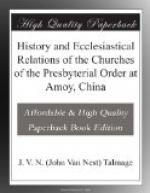After the departure of Dr. Young, all the Missionaries of the English Presbyterian Church, for several years, were unmarried men. Therefore, they resolved to devote themselves more especially to work in the country, leaving to our especial care the church in the city of Amoy, and the one out-station at Chioh-be. Amoy was still necessarily their place of residence. All their work at Amoy was in connection with the church under our care. In the country we assisted them as we had opportunity, and as occasion demanded. They did the same for us. In fact, we and they have worked together as one Church, and almost as one Mission, with the exception of keeping pecuniary matters distinct.
More recently the English Presbyterian Mission was reinforced by one member with a family, and it seemed a proper time for them to commence more direct work at Amoy. A very populous suburb (E-mng-kang) was selected as a suitable and promising station. They assumed the immediate care, and all the expense of it, employing, as at all the other stations, indiscriminately, members of their own or of our churches as helpers.
We are not afraid that our Church will ever blame us for working thus harmoniously, and unitedly, with our English Presbyterian brethren, and we feel confident that none of her Missionaries would consent to work on any other principles. If there be any who, under similar circumstances, would refuse thus to work, this would be sufficient evidence that they had mistaken their calling. If any blame is to be attached to the course the Missionaries have pursued, it is not that they have worked thus in harmony and unison with the English Presbyterian brethren, but that they have failed to keep the churches under their care ecclesiastically distinct. Some do feel inclined to censure us for this. It must be, however, because of some great misapprehension on their part. The Synod has distinctly uttered a contrary sentiment, i.e. that the course of the Missionaries is not censurable. We do not believe that our Church, when she understands the true state of the case, will ever censure us on this account. It would not be according to the spirit of her Master. He prayed that His people might be one, but he never prayed for their separation from each other. When separation is necessary, it is a necessary evil. But more of this hereafter. Our Church might well have censured us, if we had adopted lower principles as her representatives in building up the Church of Christ in China.
The first organization of a church at Amoy under our care, by the ordination of a Consistory, took place in 1856. The Missionaries of our Board then on the ground were Doty and Talmage. Mr. Douglas was the only Missionary of the English Presbyterian Church. (Mr. Joralmon, of our Church, arrived between the time of the election and the ordination of office-bearers.) When the time came for the organization of the Church, we felt a solemn responsibility resting on us.




